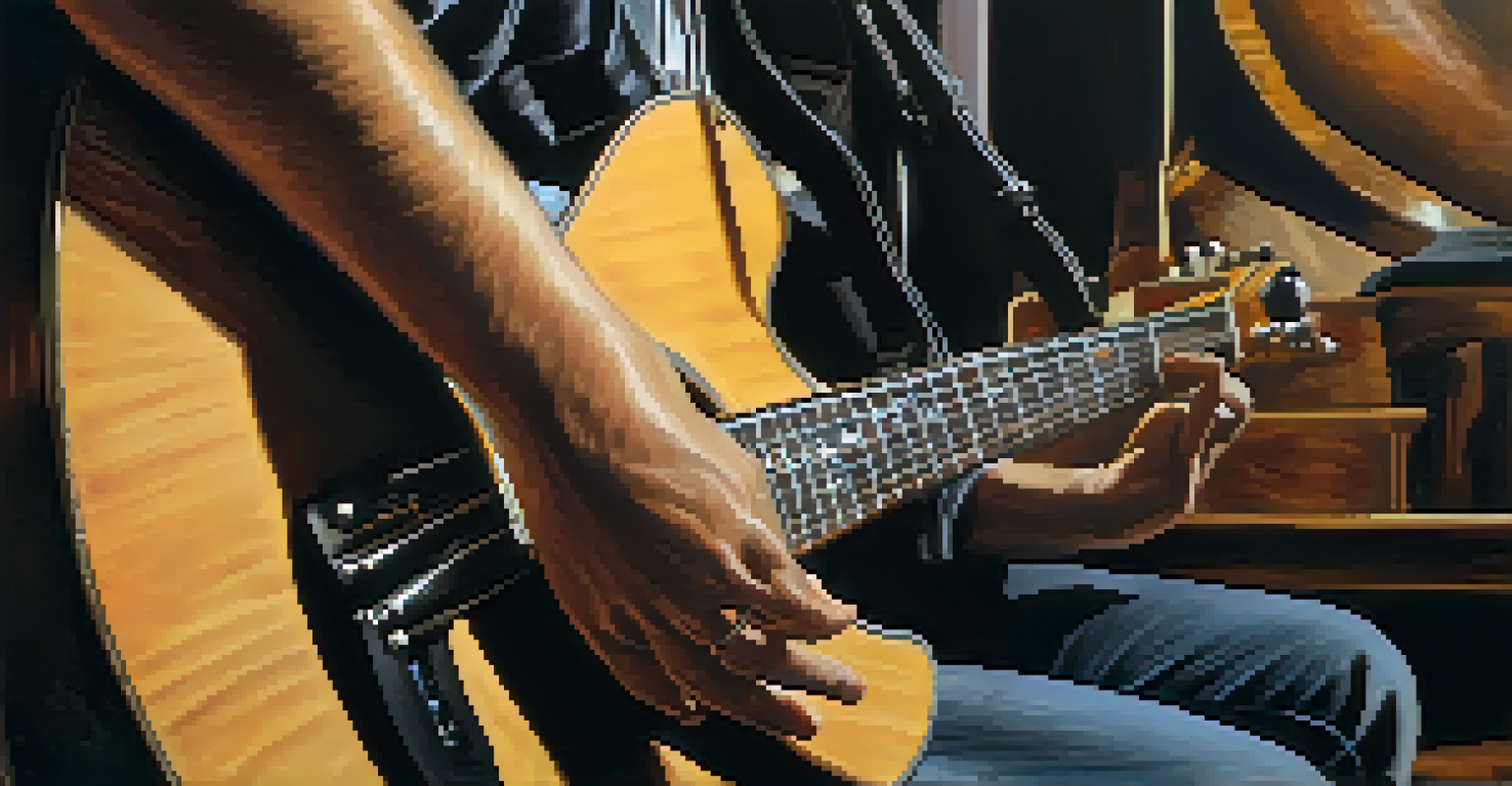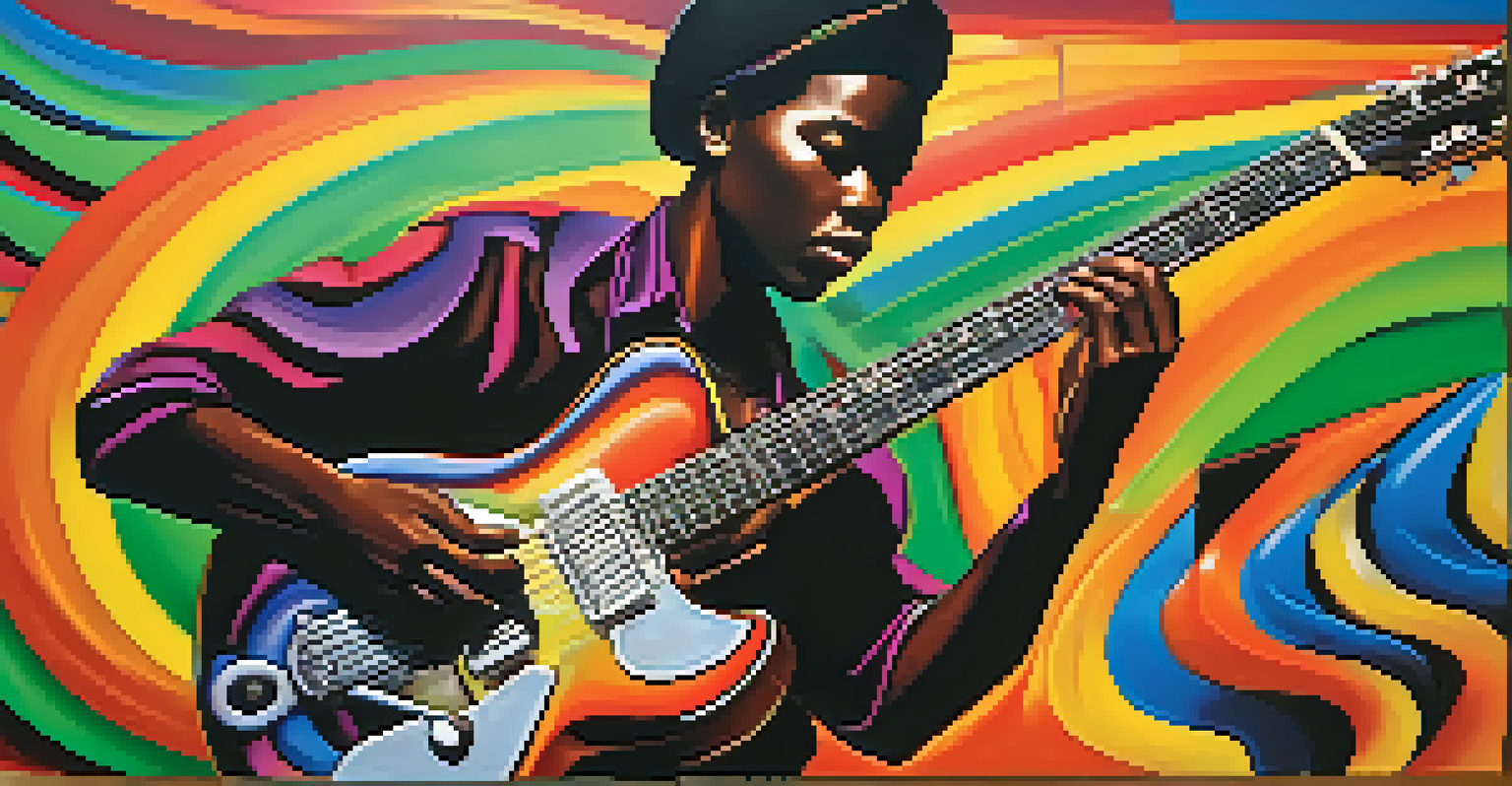Guitar Techniques Borrowed from Traditional African Music

The Rich Heritage of African Music and Its Influence
Traditional African music is a vibrant tapestry woven from various cultures and histories. It often emphasizes rhythm and community, with music being a central part of social gatherings and rituals. This rich heritage has inspired countless musicians worldwide, including guitarists looking to infuse their playing with deeper musical roots.
Music is the shorthand of emotion.
In African music, instruments like the kora and mbira are foundational, showcasing intricate finger techniques and polyrhythms that can be adapted to guitar. The focus on communal participation in music-making encourages a different approach to performance, emphasizing interaction over mere technical skill. Guitarists can learn valuable lessons by studying these traditions, enhancing their expressiveness and creativity.
By understanding the cultural significance of these techniques, guitarists can bring a unique flavor to their playing. This connection to African music not only enriches their sound but also fosters a greater appreciation for the diversity of musical expressions around the world.
Understanding Polyrhythms in African Music
Polyrhythms, where two or more contrasting rhythms are played simultaneously, are a hallmark of African music. This technique can transform the way guitarists approach rhythm, allowing for an expansive range of sounds and grooves. For example, guitarists can practice layering different strumming patterns or fingerpicking styles to create complex rhythmic textures.

To incorporate polyrhythms into your guitar playing, start with a simple base rhythm and then add a contrasting rhythm on top. This could involve alternating between a steady strumming pattern and an intricate fingerpicking sequence. As you become comfortable, you can experiment with varying tempos and accents to further develop your unique sound.
Embrace African Rhythms in Guitar
Incorporating African rhythms into guitar playing enriches compositions and engages listeners with vibrant energy.
Learning to master polyrhythms not only enhances your technical skills but also encourages a deeper musicality. Guitarists who embrace this technique often find themselves more engaged during performances, captivating their audience with dynamic and unexpected rhythms.
Exploring Call and Response Techniques
Call and response is a fundamental element in many African musical traditions, creating a dynamic dialogue between musicians. This technique can be effectively adapted for guitar, allowing players to engage with their audience or fellow musicians in a lively and interactive manner. It involves one musician (the 'caller') playing a phrase, while another (the 'responder') replies with a complementary or contrasting phrase.
The music of Africa is a reflection of the people who live there; it is about the stories they tell and the experiences they share.
Guitarists can practice this technique by crafting a simple melodic line and then responding with variations or complementary riffs. This not only builds improvisational skills but also encourages listening and adaptability. The back-and-forth nature of call and response fosters collaboration, making it a fun and enriching experience for both players and listeners.
Incorporating call and response into your practice sessions can elevate your playing style. It transforms solos into conversations, allowing you to connect more deeply with your music and audience, ultimately enhancing your overall performance.
The Role of Open Tunings in African Music
Open tunings are widely used in traditional African music, providing a unique sound and facilitating complex chord voicings. By tuning the guitar to specific pitches, players can create rich harmonies and textures that mimic the timbres of African instruments. For guitarists, exploring open tunings can open up a whole new world of creative possibilities.
To experiment with open tunings, try tuning your guitar to a major or minor chord. This allows for easier fingerings and encourages the exploration of new chord shapes and voicings. As you play, you might discover unexpected melodies and harmonies that can add depth to your compositions.
Explore Polyrhythms for Depth
Mastering polyrhythms allows guitarists to create complex rhythmic textures that enhance musicality and audience engagement.
Incorporating open tunings into your playing can deepen your understanding of harmony and melody. It encourages a more intuitive approach to music-making, allowing you to unlock the full potential of your instrument while paying homage to the traditions that shaped it.
Fingerstyle Techniques Borrowed from African Instruments
Fingerstyle playing is a technique often associated with traditional African instruments like the kora and thumb piano. This method emphasizes the use of individual fingers to pluck strings, allowing for intricate melodies and rhythmic patterns. Guitarists can adapt these techniques to create a unique sound that reflects African musical influences.
To practice fingerstyle techniques, begin with simple patterns using your thumb and fingers. Focus on creating a steady rhythm while incorporating melody lines. As you gain confidence, try integrating different fingerpicking patterns to enhance your playing and explore the nuances of this style.
Adopting fingerstyle techniques can significantly enrich your guitar playing. It not only diversifies your sound but also encourages a more intimate connection with your music, inviting listeners to experience the depth and richness of your compositions.
Improvisation and Its Importance in African Music
Improvisation is a vital aspect of African music, allowing musicians to express their individuality and creativity in real-time. This principle can be applied to guitar playing, encouraging players to step outside of their comfort zones and explore new musical ideas. Embracing improvisation can lead to fresh sounds and spontaneous moments during performances.
To develop your improvisational skills, start by familiarizing yourself with a few scales or modes. This foundation will give you the freedom to experiment with melodies and harmonies as you play. As you practice, try to let go of perfectionism and embrace the joy of spontaneous creation, much like traditional African musicians do.
Use Call and Response Techniques
Adapting call and response techniques fosters interaction and improvisation, transforming solos into dynamic musical conversations.
Improvisation not only enhances your technical abilities but also cultivates a deeper emotional connection to your music. By allowing yourself to improvise, you embrace the spirit of creativity and adventure that is at the heart of African musical traditions.
Incorporating African Rhythms into Your Guitar Playing
Integrating African rhythms into your guitar playing can add a vibrant and infectious energy to your music. These rhythms often feature complex patterns that can elevate your compositions and engage listeners. By studying traditional African rhythmic structures, guitarists can gain valuable insights into creating captivating grooves and beats.
Begin by listening to various styles of African music, paying close attention to the rhythmic patterns. Try to replicate these rhythms on your guitar, using both strumming and fingerpicking techniques. As you practice, focus on maintaining a steady pulse while exploring variations that reflect your personal style.

Incorporating African rhythms into your guitar playing not only broadens your musical repertoire but also connects you to a rich tradition of rhythm and community. This engagement encourages a more holistic approach to music, fostering collaboration and creativity in your artistry.